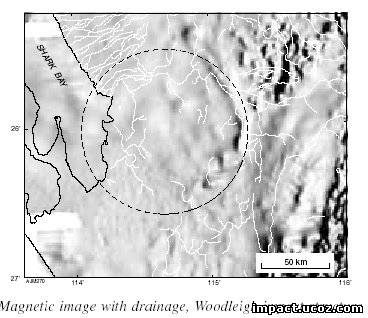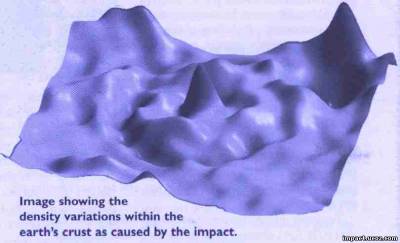- Mory Arthur J., Iasky Robert P., Glikson Andrew Y., Pirajno Franco
(2000). Woodleigh, Carnarvon Basin, Western Australia: a new 120 km
diameter impact structure . Earth and Planet. Sci. Lett., Vol.177, No.1,
P. 119-128
- Jarmo Moilanen (2004). References.
- John
G. Spray, Director PASSC (2005). Impact Structures listed by Name.
Current total number of confirmed impact structures: 172 .
- Glikson A.Y., Mory A.J., Iasky R.P., Pirajno F., Golding S.D.,
Uysal I.T. (2005). Woodleigh, Southern Carnarvon Basin, Western
Australia: History of discovery, Late Devonian age, and geophysical and
morphometric evidence for a 120 km-diameter impact structure . Austral.
J. Earth Sci., Vol.52, No.4, P. 545-553
- Glikson A.Y., Eggins S., Golding S.D., Haines P.w., Iasky R.P.,
Mernagh T.P., Mory A.J., Pirajno F., Uysal I.T. (2005). Microchemistry
and microstructures of hydrothermally altered shock-metamorphosed
basement gneiss, Woodleigh impact structure, Southern Carnavon Basin,
Western Australia . Austral. J. Earth Sci., Vol.52, No.4, P. 555-573
- Haines P.W. (2005). Impact cratering and distal ejecta: the
Australian record. Aus.Journal of Earth sciences. Vol.52, N.4/5.
Aug./Oct. p.481-507
- Pirajno F. (2005). Hydrothermal processes associated with
meteorilte impact structure: evidence from three Australian examples and
implications for economic resources . Austral. J. Earth Sci., Vol.52,
No.5, P. 587-605
- Osinski Gordon R. (2006). The geological record of meteorite
impacts. 40th ESLAB First International Conference on Impact Cratering
in the Solar System, 8-12 May 2006., Noordwijk,The Netherlands
Hidden beneath the red sand country east of Shark Bay, the crater
has been estimated to be 120 km in diameter and the extraterrestrial
body that caused it was probably 5 km in diameter. This crater is fourth
largest in the world - only the Vredefort crater in South Africa
(diameter = 300 km), the Sudbury crater in Canada (250 km), and the
Chicxulub crater in the Gulf of Mexico (> 180 km) are larger. An
impact of this size is probably related to a significant extinction in
the fossil record, similar to Chicxulub, which has been linked to the
extinction of the dinosaurs at the end of the Cretaceous period, 65
million years ago. The Woodleigh crater, however, lies buried below
more than 100 m of Cretaceous and Jurassic ( 100-200 million years old)
sedimentary rock, and so predates that event. Geophysical data, and
to a lesser extent surface drainage, were used to detect the crater,
and to estimate its size. The cen- tral part of the crater, where the
force of the impact caused the rock to "rebound" to form a dome of
highly fractured rock, is about 20 km in diameter. This process is
similar to the central peak that forms when a pebble is dropped into a
pond. Exploration for coal in the area first detected the central
uplifted part of the buried crater in the late 1970s. The signifi-
cance of the circular feature was realised only in mid-1997 dur- ing an
investigation of the Gascoyne region by GSWA geoscien- tists. They
identified the unusual deformation of the quartz minerals as diagnostic
of severe shock that developed under the extreme pressures caused by
extraterrestrial impacts. These pressures (about 100,000 times greater
than atmospheric pres- sure at sea level) are typically 10-100 times
greater than those generated from earthquake or volcanic activity. As
none of the samples from the 1981 drill-hole remain, the GSWA deepened
the original hole in March 1999 to obtain core samples to confirm the
postulated impact origin. The core shows extremely well preserved shock
metamorphic features including thin veins of melted glass, breccia,
and shocked quartz, thereby indisputably proving an impact origin. The
youngest possible age for the impact is about 200 million years ago in
the Lower Jurassic, based on the age of the crater in- fill sediments.
The oldest possible age for the impact is con- strained by isotopic
analysis of samples from the crater floor, which indicate a Late
Devonian age (about 364 million years ago). "The size of the crater
alone indicates that it would have had dramatic effects on a local and
global scale," said Rob Iasky, Senior Geophysicist. "Locally, the
impact could have triggered earthquakes and/or volcanic activity.
Global environmental effects would have been catastrophic as such large
impacts throw a huge amount of dust into the atmosphere. The resulting
lack of sunlight, temporary changes in climate, and associated
acidification of rain may cause the extinction of many species in a
manner similar to a prolonged nuclear or volcanic "winter":"
cm.
Andrew Glikson, Tonguc Uysal, Arthur Mory, Robert Iasky, Franko Pirajno, Simon Kelley, Stephen Eggins, and Richard. Armstrong
A determination of the age of the Woodleigh impact ? now the world's
4th largest - was attempted using several isotopic methods. A
pre-Jurassic age is indicated by overlying Early Jurassic sediments of
the Woodleigh Formation, restricted to the ring synclines as well as
onlapping the margins of the central uplift. The youngest deformed
sediments include lower Devonian units, setting an older age limit to
the impact. The isotopic systems of biotite in the basement uplift
remained stable in the samples analysed, as shown by (1) a model Rb-Sr
age of 835 Ma, and (2) K-Ar isotopic age of ~800 Ma, with marginal rim
resetting to about 700 Ma. However, isotopic K-Ar analysis of illite and
interleaved illite/smectite grains separated from granitoid of the
central uplift and from basal diamictite of the inner ring syncline
suggest upper Devonian ages. Thus, core sample W149148 yielded an age of
362 Ma, and K-Ar ages of illite and smectite separated from the basal
diamictite at Woodleigh 2A yield late to end-Devonian ages. Infra-red
laser spot fusion analysis indicates loss of potassium in
pseudotachylite veins in shocked granitoid, and altered K-feldspar
yielded ages mostly in the range 180-130 Ma, reflecting post-impact
burial. The diamictite contains shale clasts containing early Permian
palynomorphs, probably representing sedimentary mixing in the ring
syncline. It follows that the Woodleigh impact structure is of late to
end-Devonian age.
Woodleigh thus constitutes the largest member of a late Devonian
impact cluster, which also includes Charlevoix (Quebec), Siljan
(Sweden), Ternovka (Ukraine), Kaluga (Russia), Ilynets (Ukraine), and
Elbow (Saskatchewan). Iridium anomalies related to the late Devonian
(Frasnian-Fammenian boundary) events are known from the north Canning
Basin, Western Australia, microtektites are found along this boundary in
south China, and marked 13/12C excursions occur in Alberta. This
extinction saw the elimination of rugose coral reefs, trilobites,
ammonoids, brachiopods and conodont species, including destruction of
the Devonian reefs which fringe the Kimberley Block, north Western
Australia. A search is planned for tsunami deposits along the late
Devonian boundary in the Gascoyne Province.
Laser ablation ICP-MS and electron microscopy and microprobe studies
of pseudotachylite and impact melt-injected shock-metamorphosed
granitoid from the uplifted basement core of Woodleigh confirm earlier
indications of anomalous siderophile and magnesian element abundances
(Mg, Fe, Ni, Cr, Co, V) in the pseudotachylite and diaplectic glass
inclusions within feldspar. In the absence of ultramafic rocks in the
vicinity, it is suggested the anomalous ultramafic chemistry is related
to injection of melt and condensation of vapour phases derived from the
exploding projectile.
1
2

Спутниковая фотография района кратера из Google Earth.

|

|
Карта гравитационных аномалий
кратера Вудлэй |
Магнитные аномалии. |
cm.

magnetic intensity map
Обзор статей (из РЖ ВИНИТИ "Геология и геофизика"):
Строение, результаты гравитационных и магнитных исследований, данные
по химическому составу вещества псевдотахилитовых прожилок в гранитоидах
и возраст многокольцевого ударного бассейна Вудлей размером 120 км,
Западная Австралия. Ударное образование структуры подтверждено наличием
центрального гранитоидного поднятия размером 25 км,
ударно-индуцированных планарных деформаций в зернах кварца,
диаплектической витрификации полевого шпата, обширного
псевдотахилитового жилкования и термически измененного слоя диамицитов,
погребенных 380 м слоем озерных отложений нижнего юраса. Обогащение
вещества прожилок Al, Ca, Mg, Ni, Co, Cr, V, S и обеднение K, Si
обусловлено фракционированием элементов при ударном испарении,
внедрением и испарением метеоритного компонента и минерализацией
сульфидов. Возраст структуры (280-290 млн лет) свидетельствует о падении
тела на границе перми-триаса
(Mory Arthur J., Iasky Robert P., Glikson Andrew Y., Pirajno Franco, 2000).
Оценка первоначального размера сильно эродированной и погребенной
под слоем отложений ударной структуры Вудлэй. Гидротермальное плавление
и диаплектические превращения сильно замаскированы крупномасштабным
изменением подвергнутых удару гнейсов в монтмориллонитовые глины.
Выявлено загрязнение пород структуры метеоритным компонентом. Первичный
размер кратера составлял 120 км, возраст около 360 млн лет. Структура
имела центральный купол диаметром 37 км
(Glikson A.Y., Mory A.J., Iasky R.P., Pirajno F., Golding S.D., Uysal I.T., 2005).
Данные по хим. составу гидротермально измененных
ударно-метаморфизованных (P>20 ГПа) гнейсов фундамента ударной
структуры Wittenoom, Западная Австралия. Идентификация первичных
минералов гнейсов сильно затруднена их обширным замещением
монтмориллонитом, иллитом и серицитом. Хим. состав вторичных минералов
отличен от состава вмещающих их гнейсов. Они обогащены относительно
тугоплавкими элементами и обеднены летучими. Наблюдаемое обогащение
ударно-измененных гнейсов и пронизывающих их вторичных глинистых
минералов ферромагнезиальными Ni, Co, Cr и высокие отношения Ni/Co и
Ni/Cr обусловлены внедрением в гнейсы богатых сидерофильными элементами
флюидов ударника.
(Glikson A.Y., Eggins S., Golding S.D., Haines P.w., Iasky R.P., Mernagh T.P., Mory A.J., Pirajno F., Uysal I.T., 2005).
Влияние гидротермальных процессов, возникающих за счет
превращения кинетической энергии падающих на Землю метеоритов в
тепловую, на окружающие породы на примере ударных кратеров Шуэмакер,
Вудлэй и Яррабубба, вокруг и внутри которых обнаружены гидротермальные
флюиды. Показано, что протекание процессов от раннего
высокотемпературного щелочного метасоматоза к более позднему
низкотемпературному метасоматозу приводит к замещению первичных пород
ассоциацияями водусодержащих минералов. В этих процессах могут
образовываться и экономически значимые запасы полезных ископаемых
(Pirajno F., 2005).
|